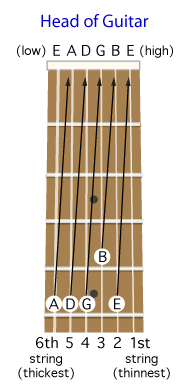Tuning the guitar with relative tuning requires that you have one string (preferably the low E) that you know is tuned to the correct pitch. You can tune the string by using a reference pitch from our free online guitar tuner or by using a digital guitar tuner. Once you have that string tuned, you can use that string to tune all the other strings using the relative tuning technique described below.
 In relative tuning, open strings are matched to fretted notes of the same pitch on other strings, as seen in the chart here and description below.
In relative tuning, open strings are matched to fretted notes of the same pitch on other strings, as seen in the chart here and description below.
5th string played open = 6th string played with finger held behind the 5th fret.
4th string played open = 5th string played with finger held behind the 5th fret.
3rd string played open = 4th string played with finger held behind the 5th fret.
2nd string played open = 3rd string played with finger held behind the 4th fret.
1st string played open = 2nd string played with finger held behind the 5th fret.
Relative Tuning Process
- The relative tuning technique requires that you have already tuned your low E (the 6th, or thickest) string. You can use a reference tone such as a reference note tuner or a guitar that is already in tune.
- Play the low E string and turn the tuning key associated with that string to tighten/loosen the string until it matches the reference pitch.
NOTE: If you’re having trouble matching the pitch, try loosening the string so you can hear it’s definitely a lot lower than your reference pitch, and then tighten the string until it’s in tune. You will hear the sound waver or “beat” slower and slower, the closer you get to being in tune. This wavering will stop when you are in tune. - Fret the low E string at the fifth fret and play the string. You are hearing the note “A.” This becomes your next reference note.
- Play the A string (string 5) and adjust the corresponding tuning peg key until the sound you hear matches the reference pitch from the tuner
- Use the chart above to continue the process for each of the strings from lowest (thickest) to highest (thinnest).
Once you’re all tuned-up, try playing a few chords to make sure everything sounds right, and make adjustments as needed. Your ear will develop over time so that eventually you’ll be able to tune your guitar quickly.